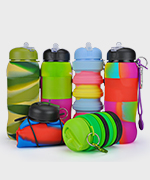About Silicone
Silicones, also known as polysiloxanes, are polymers that include any inert, synthetic compound made up of repeating units of siloxane, which is a chain of alternating silicon atoms and oxygen atoms, combined with carbon, hydrogen, and sometimes other elements. They are typically heat-resistant and either liquid or rubber-like, and are used in sealants, adhesives, lubricants, medicine, cooking utensils, and thermal and electrical insulation. Some common forms include silicone oil, silicone grease, silicone rubber, silicone resin, and silicone caulk.
Terminology and history
F. S. Kipping coined the word silicone in 1901 to describe polydiphenylsiloxane by analogy of its formula, Ph2SiO (Ph stands for phenyl, C6H5), with the formula of the ketone benzophenone, Ph2CO (his term was originally silicoketone). Kipping was well aware that polydiphenylsiloxane is polymeric whereas benzophenone is monomeric and noted that Ph2SiO and Ph2CO had very different chemistry. The discovery of the structural differences between Kipping's molecules and the ketones means that silicone is no longer the correct term (though it remains in common usage) and that the term siloxanes is correct according to the nomenclature of modern chemistry.
Silicone is sometimes mistakenly referred to as silicon. The chemical element silicon is a crystalline metalloid widely used in computers and other electronic equipment. Although silicones contain silicon atoms, they also include carbon, hydrogen, oxygen, and perhaps other kinds of atoms as well, and have physical and chemical properties that are very different from elemental silicon.
A true silicone group with a double bond between oxygen and silicon does not commonly exist in nature; chemists find that the silicon atom prefer to form single bonds with each of two oxygen atoms, forming a chain, rather than a double bond to a single atom. Polysiloxanes are among the many substances commonly known as "silicones".
Molecules containing silicon-oxygen double bonds do exist and are called silanones but they are very reactive. Despite this, silanones are important as intermediates in gas-phase processes such as chemical vapor deposition in microelectronics production, and in the formation of ceramics by combustion.
Silicones exhibit many useful characteristics, including:
- Low thermal conductivity
- Low chemical reactivity
- Low toxicity
- Thermal stability (constancy of properties over a wide temperature range of −100 to 250 °C).
- The ability to repel water and form watertight seals.
- Does not stick to many substrates, but adheres very well to others, e.g. glass.
- Does not support microbiological growth.
- Resistance to oxygen, ozone, and ultraviolet (UV) light. This property has led to widespread use of silicones in the construction industry (e.g. coatings, fire protection, glazing seals) and the automotive industry (external gaskets, external trim).
- Electrical insulation properties. Because silicone can be formulated to be electrically insulative or conductive, it is suitable for a wide range of electrical applications.
- High gas permeability: at room temperature (25 °C), the permeability of silicone rubber for such gases as oxygen is approximately 400 times[citation needed] that of butyl rubber, making silicone useful for medical applications in which increased aeration is desired. Conversely, silicone rubbers cannot be used where gas-tight seals are necessary.
Silicone can be developed into rubber sheeting, where it has other properties, such as being FDA compliant. This extends the uses of silicone sheeting to industries that demand hygiene, for example, food and beverage and pharmaceutical.
Uses
Silicones are used in many products. Ullmann's Encyclopedia of Industrial Chemistry lists the following major categories of application: Electrical (e.g., insulation), electronics (e.g., coatings), household (e.g., sealants for cooking apparatus), automobile (e.g., gaskets), aeroplane (e.g., seals), office machines (e.g., keyboard pads), medicine and dentistry (e.g., tooth impression molds), textiles and paper (e.g., coatings). For these applications, an estimated 400,000 tons of silicones were produced in 1991.[clarification needed] Specific examples, both large and small are presented below.
Cookware
- As a low-taint, non-toxic material, silicone can be used where contact with food is required. Silicone is becoming an important product in the cookware industry, particularly bakeware and kitchen utensils.
- Silicone is used as an insulator in heat-resistant potholders and similar items; however, it is more conductive of heat than similar less dense fiber-based products. Silicone oven mitts are able to withstand temperatures up to 260 °C (500 °F), allowing reaching into boiling water.
- Molds for chocolate, ice, cookies, muffins and various other foods.
- Non-stick bakeware and reusable mats used on baking sheets.
- Other products such as steamers, egg boilers or poachers, cookware lids, pot holders, trivets, and kitchen mats.









